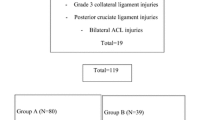Abstract
Introduction
This study aimed to evaluate the treatment outcome of patients with anterior cruciate ligament (ACL) injury using the patient-based quality of life (QOL) survey SF-36, and investigate the correlation with conventional objective assessment methods. Our hypothesis that SF-36 is a useful assessment method for QOL in patients with ACL injury, and this assessment clarifies the concord and the discord between doctor-based objective assessment.
Patients and methods
A prospective study was conducted on patients who underwent ligament reconstruction. Eighty-one patients with a mean age of 27.4 years were analyzed. Clinical evaluations comprising SF-36 survey, Lysholm scoring, and anterior tibial translation measurement were conducted before as well as after surgery. The changes over time and the correlation between these evaluation methods were analyzed.
Results
All SF-36 subscales were significantly improved after surgery. Regarding QOL of patients with ACL injury, the preoperative scores of all the subscales except vitality and mental health were lower than the national standard values, while the postoperative scores of all subclasses were not different from the national standards. A correlation was found between Lysholm score and all SF-36 subscale scores except general health before surgery, but a correlation was observed only with physical functioning, bodily pain and role emotional at 6 months after surgery, and with physical functioning, role physical, bodily pain and vitality at 12 months. No correlation between SF-36 scores and distance of anterior tibial translation was observed both before and after surgery.
Discussion
The QOL of patients with ACL injury as assessed by SF-36 improved significantly after reconstruction surgery. The mental health subscales of SF-36 correlate with Lysholm score before surgery suggesting that apart from the physical impairment, lowered mental health is also an important clinical issue in patients with ACL injury.

Similar content being viewed by others
References
Johnson DS, Smith RB (2001) Outcome measurement in ACL deficient knee. What’s the score? Knee 8(1):51–57
Wilk KE, Romaniello WT, Soscia SM et al (1994) The relationship between subjective knee scores, isokinetic testing, and functional testing in the ACL-reconstructed knee. J Orthop Sports Phys Ther 20(2):60–73
Muneta T, Sekiya I, Oguchi T et al (1998) Objective factors affecting overall subjective evaluation of recovery after anterior cruciate ligament reconstruction. Scand J Med Sci Sports 8:283–289
Diekstall P, Rauhut F (1999) Considerations for the indications for anterior cruciate ligament reconstruction. Results of conservative versus operative treatment. Unfallchirurg 102:173–181
Hinterwimmer S, Engelschalk M, Sauerland S et al (2003) Operative or conservative treatment of anterior cruciate ligament rupture: a systematic review of the literature. Unfallchirurg 106(5):374–379
Fukuhara S, Suzukamo Y (2004) Manual of SF-36v2 Japanese version. Institute for Health Outcomes and Process Evaluation Research, Kyoto
Fukuhara S, Ware JE Jr, Kosinski M (1998) Psychometric and clinical tests of validity of the Japanese SF-36 health survey. J Clin Epidemiol 51:1045–1053
Ochiai S, Hagino T, Tonotsuka H et al (2009) Health-related quality of life in patients with an anterior cruciate ligament injury. Arch Orthop Trauma Surg. http://www.springerlink.com/content/625hq44093p98u1v/
Calvisi V, De Vincentiis B, Palumbo P et al (2008) Health-related quality of life in patients with anterior cruciate ligament insufficiency undergoing arthroscopic reconstruction: a practice-based Italian normative group in comorbid-free patients. J Orthop Traumatol 9(4):233–238
Möller E, Weidenhielm L, Werner S (2009) Outcome and knee-related quality of life after anterior cruciate ligament reconstruction: a long-term follow-up. Knee Surg Sports Traumatol Arthrosc 17(7):786–794
Rosenberg TD, Graf B (1994) Technique for ACL reconstruction with Multi-Trac drill guide. Acufex Microsurgical
Cho KO (1975) Reconstruction of the anterior cruciate ligament by semitendinosus tenodosis. J Bone Joint Surg 57A:608–612
Tegner Y, Lysholm J (1985) Rating systems in the evaluation of knee ligaments injuries. Clin Orthop Relat Res 198:43–49
Rijke AM, Tegtmeyer CJ, Weiland DJ (1987) Stress examination of the cruciate ligaments; a radiologic Lachman test. Radiology 165:867–869
Beaton DE, Schemitsch E (2003) Measures of health-related quality of life and physical function. Clin Orthop 413:90–105
Shapiro ET, Richmond JC, Rockett SE et al (1996) The use of a generic, patient-based health assessment (SF-36) for evaluation of patients with anterior cruciate ligament injuries. Am J Sports Med 24(2):196–200
Liang MH, Fossel AH, Larson MG (1990) Comparison of five health status instruments for orthopedic evaluation. Med Care 28:632–642
Hawkins RJ, Misamore GW, Merritt TR (1986) Follow-up of the acute nonoperated isolated anterior cruciate ligament tear. Am J Sports Med 14(3):205–210
Barber SD, Noyes FR, Mangine RE, McCloskey JW et al (1990) Quantitative assessment of functional limitations in normal and anterior cruciate ligament-deficient knees. Clin Orthop Relat Res 255:204–214
Ware JE Jr, Sherbourne CD (1992) The MOS 36-item short-form health survey (SF-36) I. Conceptual framework and item selection. Med Care 30(6):473–483
Aaronson NK, Acquadro C, Fukuhara S et al (1992) International Quality of Life Assessment (IQOLA) Project. Qual Life Res 1(5):349–351
Author information
Authors and Affiliations
Corresponding author
Rights and permissions
About this article
Cite this article
Ochiai, S., Hagino, T., Tonotsuka, H. et al. Prospective analysis of health-related quality of life and clinical evaluations in patients with anterior cruciate ligament injury undergoing reconstruction. Arch Orthop Trauma Surg 131, 1091–1094 (2011). https://doi.org/10.1007/s00402-011-1309-2
Received:
Published:
Issue Date:
DOI: https://doi.org/10.1007/s00402-011-1309-2




